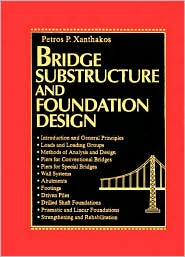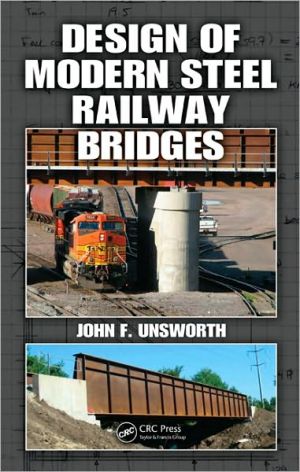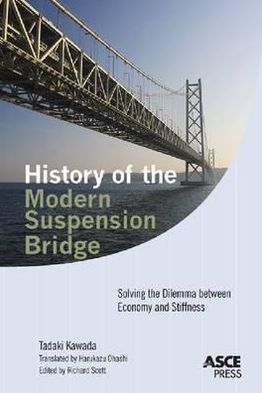Bridge Substructure and Foundation Design
Helps engineers optimize both structural reliability and economy by presenting both traditional allowable stress design concepts and newer, statistically-based load and resistance factor methodologies.\ This book provides a systematic study of bridge substructure and foundation elements, presents explicit methods of analysis, design and detailing, and offers case studies. It helps engineers understand the structural consequences of settlement and movement, evaluate alternatives to deep...
Search in google:
Helps engineers optimize both structural reliability and economy by presenting both traditional allowable stress design concepts and newer, statistically-based load and resistance factor methodologies.This book provides a systematic study of bridge substructure and foundation elements, presents explicit methods of analysis, design and detailing, and offers case studies. It helps engineers understand the structural consequences of settlement and movement, evaluate alternatives to deep foundation systems, and presents solutions for designing piers for segmental bridges. It reflects the distinct evolution in bridge design concepts, theories and analysis methods that has recently taken place.Federal, state and municipal bridge engineers, consulting engineers designing transportation structures, public works contractors, structural and geotechnical engineers, transportation engineers, public works administrators, researchers, faculty and graduate students. Booknews A text that presents a systems study of substructure and foundation elements; introduces an independent design methodology which demonstrates compliance with AASHTO and other relevant specifications; covers both the allowable stress method and the LRFD approach; and includes a sufficient number of design examples and case studies that show how to obtain credible solutions. The volume contains 12 chapters: introduction and general principles, loads and loading groups, methods of analysis and design, piers for conventional bridges, piers for special bridges, wall systems, abutments, footings, driven piles, drilled shaft foundations, prismatic and linear foundations, and strengthening and rehabilitating. Annotation c. Book News, Inc., Portland, OR (booknews.com)
Substructures and foundations constitute formidable components of bridges, and often represent more than half of the total bridge cost. The methods of analysis, design, and detailing are therefore important, and can influence the structural performance and project budget. The current extensive body of knowledge documents the concerted efforts made to advance the theory and practice of bridge engineering. This progress has encompassed the design of piers, abutments, walls and foundations, and is also evident in our present understanding of soil- structure interaction. Notable improvements are reflected in the use of materials with better physical and structural characteristics, and in the rational and more explicit analysis of structural behavior. In the present synthesis of the new and old concepts, traditional approaches have been integrated with recently evolved design philosophies, producing design options that enhance the field of structural analysis. Thus, the deterministic methodology represented in the past by the allowable stress design can now be supplemented or completely replaced by load factor design, a statistically-based probabilistic approach. Although many engineers believe that in this merge certain discernible gaps and inconsistencies are bound to remain for some time, the concensus of opinion is that in the field of bridge design there are now more workable alternatives that can be successfully applied to the entire structure and its foundation. The introduction of load factor design is now a key feature of structural analysis in most areas of structural engineering and in most parts of the world. Whereas it draws from completed research as well as from judgment, it also signifies new provisions and major areas of change. It addresses load and force models, load factors, nominal resistance and resistance factors, limit states, and the soil-structure system on a global basis. A logical extension is the consideration of the variability in the characteristics of structural elements, which is treated as the variability in the loads. Thus, the underlying philosophy moves bridge design toward a more rational and probability-based procedure, although the application of the working stress method is not excluded as an independent option. The text is developed to achieve the following objectives: (a) present a systems study of substructure and foundation elements; (b) introduce an independent design methodology demonstrating compliance with AASHTO and other relevant specifications; (c) cover both the allowable stress method and the LRFD approach; and (d) include a sufficient number of design examples and case studies that show how to obtain credible solutions. Chapter 1 provides a general review of pier types, abutments, wall systems, and foundation elements. Structure appearance and esthetics are discussed in conjunction with economic aspects. It appears that the process of selecting the visual characteristics of bridges and substructures represents largely an effort to create forms pleasing to the public in a format described in national terms, although bridge esthetics should also be examined in the context of structural requirements and budget con straints. Chapter 1 is completed with a discussion of subsurface explorations and foundation investigations, review of specifications and standards, and the fundamentals of cost relationship between superstructure and substructure. Loads and loading groups are reviewed in Chapter 2. A comparison of design loads used in the United States and in other countries shows a broad variability in load models and magnitudes. However, the present AASHTO loads and forces have been expanded by the load models of the LRFD specifications, and these are intended to enhance the live load representation. As a logical exercise of resourceful judgment, the new loads could be scaled by appropriate load factors to be compatible with other load spectra. Chapter 3 deals with methods of analysis and design, and articulates allowable stress and strength design procedures. A main concern is the reliability and uncertainty in the structural analysis. In routine practice, safety in working stress design is ensured by the application of a single factor of safety, usually taken as the ratio of design resistance to the design load. With the LRFD approach, reliability is ensured by treating both loads and resistances as random variables. Safety in the case is defined in terms of the probability of survival or the probability of failure. Conventional piers are discussed in Chapter 4. This category includes piers for all-concrete slab bridges, concrete deck bridges on multi-beam systems, two-girder systems with floor beams and stringers, truss bridges, and bridges across waterways and rivers. Although the great variety of functional, structural and geometric requirements implies a corresponding variety of pier forms and configurations, this seeming multiplicity is reduced and consolidated to a discussion of pier selection criteria, load effects, column analysis, seismic considerations, structural capacity under combined axial compression and bending, section analysis, pier frame analysis, and piers integral with the superstructure. This chapter includes also a review of pier protection design provisions in navigable waterways.
PrefaceCh. 1Introduction and General Principles1Ch. 2Loads and Loading Groups72Ch. 3Methods of Analysis and Design127Ch. 4Piers for Conventional Bridges184Ch. 5Piers for Special Bridges298Ch. 6Wall Systems381Ch. 7Abutments449Ch. 8Footings510Ch. 9Driven Piles588Ch. 10Drilled Shaft Foundations678Ch. 11Prismatic and Linear Foundations753Ch. 12Strengthening and Rehabilitation783Index839
\ BooknewsA text that presents a systems study of substructure and foundation elements; introduces an independent design methodology which demonstrates compliance with AASHTO and other relevant specifications; covers both the allowable stress method and the LRFD approach; and includes a sufficient number of design examples and case studies that show how to obtain credible solutions. The volume contains 12 chapters: introduction and general principles, loads and loading groups, methods of analysis and design, piers for conventional bridges, piers for special bridges, wall systems, abutments, footings, driven piles, drilled shaft foundations, prismatic and linear foundations, and strengthening and rehabilitating. Annotation c. Book News, Inc., Portland, OR (booknews.com)\ \








